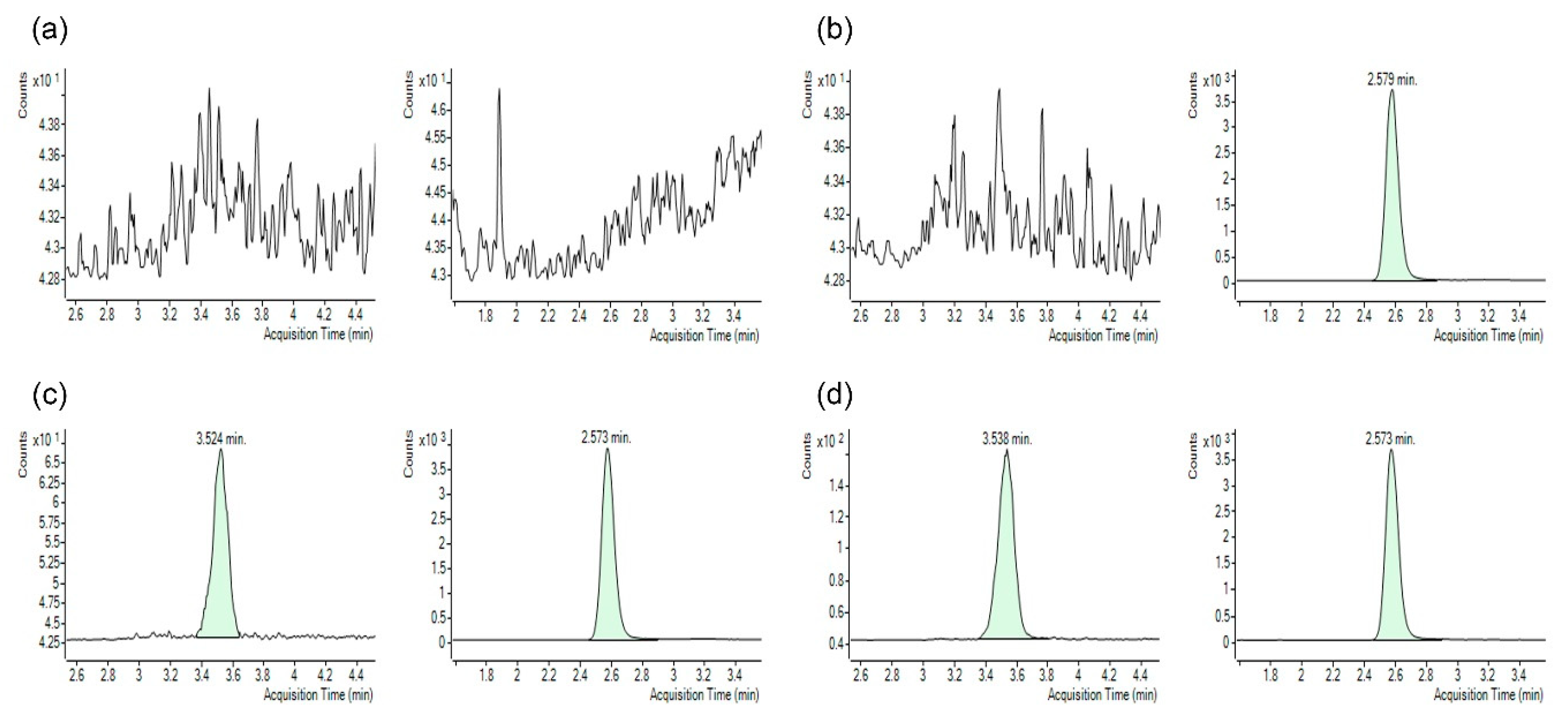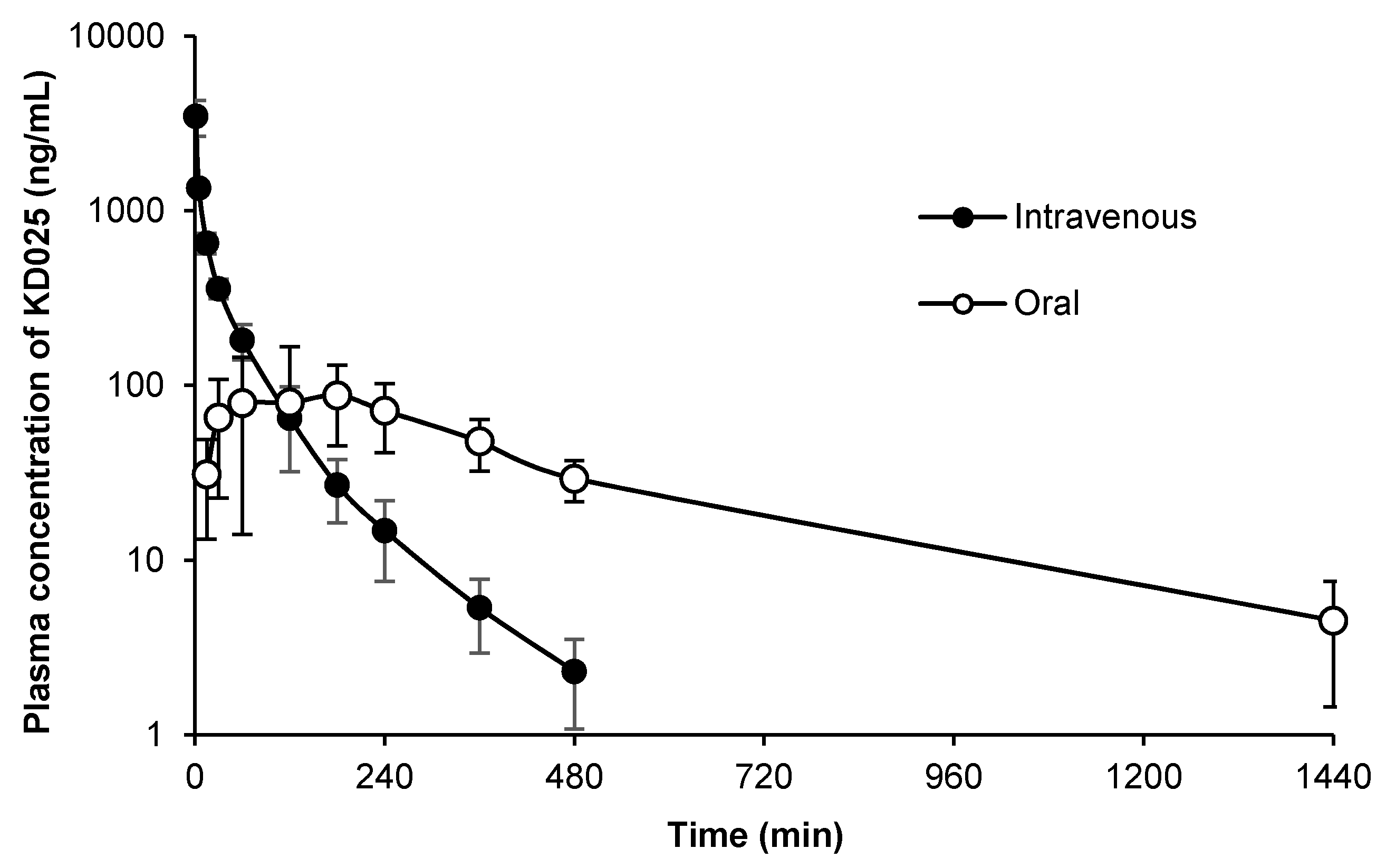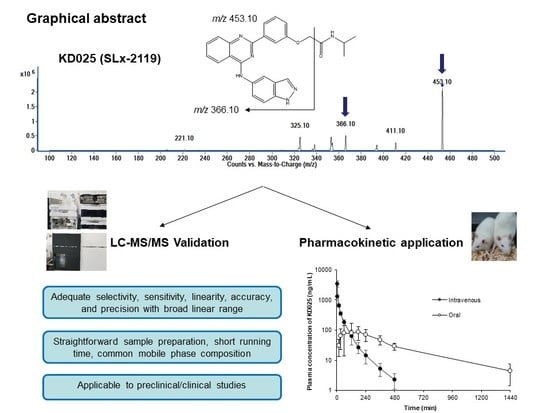Determination of KD025 (SLx-2119), a Selective ROCK2 Inhibitor, in Rat Plasma by High-Performance Liquid Chromatography-Tandem Mass Spectrometry and Its Pharmacokinetic Application
Abstract
1. Introduction
2. Results and Discussion
2.1. Mass Spectrometry and Chromatography
2.2. Method Validation
2.2.1. Selectivity
2.2.2. Linearity
2.2.3. Precision and Accuracy
2.2.4. Sensitivity
2.2.5. Matrix Effect and Extraction Recovery
2.2.6. Stability
2.3. Applicability of the Assay to Pharmacokinetic Studies
3. Materials and Methods
3.1. Reagents and Materials
3.2. Instrumentation and Analytical Conditions
3.3. Preparation of Standards and Quality Control Samples
3.4. Assay Validation
3.5. Application to Pharmacokinetic Study
4. Conclusions
Author Contributions
Funding
Conflicts of Interest
References
- Jaffe, A.B.; Hall, A. Rho GTPases: Biochemistry and Biology. Annu. Rev. Cell Dev. Biol. 2005, 21, 247–269. [Google Scholar] [CrossRef]
- Defert, O.; Boland, S. Rho kinase inhibitors: A patent review (2014–2016). Expert Opin. Ther. Pat. 2017, 27, 507–515. [Google Scholar] [CrossRef]
- Hartmann, S.; Ridley, A.J.; Lutz, S. The Function of Rho-Associated Kinases ROCK1 and ROCK2 in the Pathogenesis of Cardiovascular Disease. Front. Pharm. 2015, 6, 276. [Google Scholar] [CrossRef]
- Sardana, M.; Moll, M.; Farber, H.W. Novel investigational therapies for treating pulmonary arterial hypertension. Expert Opin. Investig. Drugs 2015, 24, 1571–1596. [Google Scholar] [CrossRef]
- Rao, P.V.; Pattabiraman, P.P.; Kopczynski, C. Role of the Rho GTPase/Rho kinase signaling pathway in pathogenesis and treatment of glaucoma: Bench to bedside research. Exp. Eye Res. 2017, 158, 23–32. [Google Scholar] [CrossRef]
- Huang, Y.; Xiao, S.; Jiang, Q. Role of Rho kinase signal pathway in inflammatory bowel disease. Int. J. Clin. Exp. Med. 2015, 8, 3089–3097. [Google Scholar]
- Shapiro, L.P.; Kietzman, H.W.; Guo, J.; Rainnie, D.G.; Gourley, S.L. Rho-kinase inhibition has antidepressant-like efficacy and expedites dendritic spine pruning in adolescent mice. Neurobiol. Dis. 2019, 124, 520–530. [Google Scholar] [CrossRef]
- Richardson Bryan, T.; Dibble Christopher, F.; Borikova Asya, L.; Johnson Gary, L. Cerebral cavernous malformation is a vascular disease associated with activated RhoA signaling. Biol. Chem. 2013, 394, 35. [Google Scholar] [CrossRef]
- Lai, A.Y.; McLaurin, J. Rho-associated protein kinases as therapeutic targets for both vascular and parenchymal pathologies in Alzheimer’s disease. J. Neurochem. 2018, 144, 659–668. [Google Scholar] [CrossRef]
- Knipe, R.S.; Tager, A.M.; Liao, J.K. The Rho kinases: Critical mediators of multiple profibrotic processes and rational targets for new therapies for pulmonary fibrosis. Pharmacol. Rev. 2015, 67, 103–117. [Google Scholar] [CrossRef]
- Holvoet, T.; Devriese, S.; Castermans, K.; Boland, S.; Hindryckx, P.; Bourin, A.; De Vos, M.; Defert, O.; Laukens, D. Mo1762 Soft Rock Inhibition Prevents Intestinal Fibrosis in a Murine Colitis Model. Gastroenterology 2015, 148, S-705. [Google Scholar] [CrossRef]
- Wei, L.; Surma, M.; Shi, S.; Lambert-Cheatham, N.; Shi, J. Novel Insights into the Roles of Rho Kinase in Cancer. Arch. Immunol. Ther. Exp. 2016, 64, 259–278. [Google Scholar] [CrossRef]
- Rath, N.; Olson, M.F. Rho-associated kinases in tumorigenesis: Re-considering ROCK inhibition for cancer therapy. EMBO Rep. 2012, 13, 900–908. [Google Scholar] [CrossRef]
- Takayasu, M.; Suzuki, Y.; Shibuya, M.; Asano, T.; Kanamori, M.; Okada, T.; Kageyama, N.; Hidaka, H. The effects of HA compound calcium antagonists on delayed cerebral vasospasm in dogs. J. Neurosurg. 1986, 65, 80. [Google Scholar] [CrossRef]
- Garnock-Jones, K.P. Ripasudil: First Global Approval. Drugs 2014, 74, 2211–2215. [Google Scholar] [CrossRef]
- Feng, Y.; LoGrasso, P.V.; Defert, O.; Li, R. Rho Kinase (ROCK) Inhibitors and Their Therapeutic Potential. J. Med. Chem. 2016, 59, 2269–2300. [Google Scholar] [CrossRef]
- Yang, Z.; Wang, J.; Liu, X.; Cheng, Y.; Deng, L.; Zhong, Y. Y-39983 downregulates RhoA/Rho-associated kinase expression during its promotion of axonal regeneration. Oncol. Rep. 2013, 29, 1140–1146. [Google Scholar] [CrossRef]
- Arimura, N.; Inagaki, N.; Chihara, K.; Ménager, C.; Nakamura, N.; Amano, M.; Iwamatsu, A.; Goshima, Y.; Kaibuchi, K. Phosphorylation of collapsin response mediator protein-2 by Rho-kinase Evidence for two separate signaling pathways for growth cone collapse. J. Biol. Chem. 2000, 275, 23973–23980. [Google Scholar] [CrossRef]
- Hyun Lee, J.; Zheng, Y.; von Bornstadt, D.; Wei, Y.; Balcioglu, A.; Daneshmand, A.; Yalcin, N.; Yu, E.; Herisson, F.; Atalay, Y.B.; et al. Selective ROCK2 inhibition in focal cerebral ischemia. Ann. Clin. Transl. Neurol. 2014, 1, 2–14. [Google Scholar] [CrossRef]
- Schueller, O.; Tong, W.; Ferkany, J.W.; Sweetnam, P. Abstract 1216: Selective ROCK 2 Inhibition Attenuates Arterial Plaque Formation in an ApoE Knockout Mouse Model. Circulation 2006, 114, II_228. [Google Scholar] [CrossRef]
- Koch, J.C.; Tatenhorst, L.; Roser, A.-E.; Saal, K.-A.; Tönges, L.; Lingor, P. ROCK inhibition in models of neurodegeneration and its potential for clinical translation. Pharmacol. Ther. 2018, 189, 1–21. [Google Scholar] [CrossRef]
- Zhou, Q.; Gensch, C.; Liao, J.K. Rho-associated coiled-coil-forming kinases (ROCKs): Potential targets for the treatment of atherosclerosis and vascular disease. Trends Pharmacol. Sci. 2011, 32, 167–173. [Google Scholar] [CrossRef]
- Diep, D.T.V.; Duong, K.H.M.; Choi, H.; Jun, H.-S.; Chun, K.-H. KD025 (SLx-2119) suppresses adipogenesis at intermediate stage in human adipose-derived stem cells. Adipocyte 2019, 8, 114–124. [Google Scholar] [CrossRef]
- Wei, L.; Surma, M.; Yang, Y.; Tersey, S.; Shi, J. ROCK2 inhibition enhances the thermogenic program in white and brown fat tissue in mice. FASEB J. 2020, 34, 474–493. [Google Scholar] [CrossRef]
- Park, J.; Chun, K.-H. Identification of novel functions of the ROCK2-specific inhibitor KD025 by bioinformatics analysis. Gene 2020, 737, 144474. [Google Scholar] [CrossRef]
- Diep, D.T.V.; Hong, K.; Khun, T.; Zheng, M.; ul-Haq, A.; Jun, H.-S.; Kim, Y.-B.; Chun, K.-H. Anti-adipogenic effects of KD025 (SLx-2119), a ROCK2-specific inhibitor, in 3T3-L1 cells. Sci. Rep. 2018, 8, 2477. [Google Scholar] [CrossRef]
- Rozo, C.; Chinenov, Y.; Maharaj, R.K.; Gupta, S.; Leuenberger, L.; Kirou, K.A.; Bykerk, V.P.; Goodman, S.M.; Salmon, J.E.; Pernis, A.B. Targeting the RhoA-ROCK pathway to reverse T-cell dysfunction in SLE. Ann. Rheum. Dis. 2017, 76, 740–747. [Google Scholar] [CrossRef]
- Yang, W.; Zhou, G.; Yu, T.; Chen, L.; Yu, L.; Guo, Y.; Cong, Y.; Liu, Z. Critical role of ROCK2 activity in facilitating mucosal CD4+ T cell activation in inflammatory bowel disease. J. Autoimmun. 2018, 89, 125–138. [Google Scholar] [CrossRef]
- Flynn, R.; Paz, K.; Du, J.; Reichenbach, D.K.; Taylor, P.A.; Panoskaltsis-Mortari, A.; Vulic, A.; Luznik, L.; MacDonald, K.K.P.; Hill, G.R.; et al. Targeted Rho-associated kinase 2 inhibition suppresses murine and human chronic GVHD through a Stat3-dependent mechanism. Blood 2016, 127, 2144–2154. [Google Scholar] [CrossRef]
- Boerma, M.; Fu, Q.; Wang, J.; Loose, D.S.; Bartolozzi, A.; Ellis, J.L.; McGonigle, S.; Paradise, E.; Sweetnam, P.; Fink, L.M.; et al. Comparative gene expression profiling in three primary human cell lines after treatment with a novel inhibitor of Rho kinase or atorvastatin. Blood Coagul Fibrinolysis 2008, 19, 709–718. [Google Scholar] [CrossRef]
- Niego, B.E.; Lee, N.; Larsson, P.; De Silva, T.M.; Au, A.E.L.; McCutcheon, F.; Medcalf, R.L. Selective inhibition of brain endothelial Rho-kinase-2 provides optimal protection of an in vitro blood-brain barrier from tissue-type plasminogen activator and plasmin. PLoS ONE 2017, 12, e0177332. [Google Scholar] [CrossRef]
- Zanin-Zhorov, A.; Weiss, J.M.; Nyuydzefe, M.S.; Chen, W.; Scher, J.U.; Mo, R.; Depoil, D.; Rao, N.; Liu, B.; Wei, J.; et al. Selective oral ROCK2 inhibitor down-regulates IL-21 and IL-17 secretion in human T cells via STAT3-dependent mechanism. Proc. Natl. Acad. Sci. USA 2014, 111, 16814–16819. [Google Scholar] [CrossRef]
- Zanin-Zhorov, A.; Weiss, J.M.; Trzeciak, A.; Chen, W.; Zhang, J.; Nyuydzefe, M.S.; Arencibia, C.; Polimera, S.; Schueller, O.; Fuentes-Duculan, J.; et al. Cutting Edge: Selective Oral ROCK2 Inhibitor Reduces Clinical Scores in Patients with Psoriasis Vulgaris and Normalizes Skin Pathology via Concurrent Regulation of IL-17 and IL-10. J. Immunol. 2017, 198, 3809–3814. [Google Scholar] [CrossRef]
- Jagasia, M.; Salhotra, A.; Bachier, C.R.; Essell, J.H.; Weisdorf, D.J.; Lazaryan, A.; Zoghi, B.; Green, L.S.; Schueller, O.; Zanin-Zhorov, A.; et al. KD025-208: A Phase 2a Study of KD025 for Patients with Chronic Graft Versus Host Disease (cGVHD)—Pharmacodynamics (PD) and Updated Results. Biol. Blood Marrow Transplant. 2019, 25, S28–S29. [Google Scholar] [CrossRef]
- Jagasia, M.; Salhotra, A.; Bachier, C.R.; Zoghi, B.; Lazaryan, A.; Weisdorf, D.J.; Essell, J.; Green, L.S.; Schueller, O.; Huang, L.; et al. KD025 for Patients with Chronic Graft-Versus-Host Disease (cGVHD)—Long-Term Follow-up of a Phase 2a Study (KD025-208). Blood 2019, 134, 872. [Google Scholar] [CrossRef]
- Salhotra, A.; Zoghi, B.; Essell, J.; Bachier, C.R.; Weisdorf, D.J.; Lazaryan, A.; Green, L.S.; Schueller, O.; Huang, L.; Yang, Z.; et al. KD025-208: A Phase 2A Trial of KD025 for Patients with Chronic Graft-Versus-Host Disease (CGVHD)—Updated Safety and Efficacy: PS1533. HemaSphere 2019, 3, 707–708. [Google Scholar] [CrossRef]
- Albertson, T.E.; Baratz, D.M.; Chaudhary, S.; Mobin, S.; O’Brien, T.; Scholand, M.B.; Whelan, T.P.M.; Poyurovsky, M.; Schueller, O.; Ryan, J.; et al. A Phase 2 Trial of KD025 to Assess Efficacy, Safety and Tolerability in Patients with Idiopathic Pulmonary Fibrosis. In C97. Diffuse Parenchymal Lung Diseases: Evaluation, Outcomes, and Trials; American Thoracic Society: San Diego, CA, USA, 2018; p. A5927. [Google Scholar]
- Woolf, E.J.; McDougall, S.; Fast, D.M.; Andraus, M.; Barfield, M.; Blackburn, M.; Gordon, B.; Hoffman, D.; Inoue, N.; Marcelin-Jimenez, G.; et al. Small molecule specific run acceptance, specific assay operation, and chromatographic run quality assessment: Recommendation for best practices and harmonization from the global bioanalysis consortium harmonization teams. AAPS J. 2014, 16, 885–893. [Google Scholar] [CrossRef]
- US Food and Drug Administration (FDA). Bioanalytical Method Validation Guidance for Industry. 2018. Available online: https://www.fda.gov/regulatory-information/search-fda-guidance-documents/bioanalytical-method-validation-guidance-industry (accessed on 4 June 2019).
- Jin, H.-E.; Kim, I.-B.; Kim, Y.C.; Cho, K.H.; Maeng, H.-J. Determination of cefadroxil in rat plasma and urine using LC–MS/MS and its application to pharmacokinetic and urinary excretion studies. J. Chromatogr. B 2014, 947–948, 103–110. [Google Scholar] [CrossRef]
- Kim, M.J.; Kwon, S.H.; Jang, C.G.; Maeng, H.J. Determination of isoorientin levels in rat plasma after oral administration of Vaccinum bracteatum Thunb. methanol extract by high-performance liquid chromatography-tandem mass spectrometry. Biomed. Chromatogr. 2018, 32, e4188. [Google Scholar] [CrossRef]
- Balla, A.; Cho, K.H.; Kim, Y.C.; Maeng, H.-J. Simultaneous Determination of Procainamide and N-acetylprocainamide in Rat Plasma by Ultra-High-Pressure Liquid Chromatography Coupled with a Diode Array Detector and Its Application to a Pharmacokinetic Study in Rats. Pharmaceutics 2018, 10, 41. [Google Scholar] [CrossRef]
- Nguyen, T.-T.-L.; Duong, V.-A.; Maeng, H.-J.; Chi, S.-C. Development of an oil suspension containing granisetron hydrochloride as a sustained-release parenteral formulation for enhancement of pharmacokinetic properties. J. Drug Deliv. Sci. Technol. 2019, 51, 643–650. [Google Scholar] [CrossRef]
Sample Availability: Samples of the compounds KD025 and GSK429286A are available from the authors. |




| Added Concentration (Plasma Sample, ng/mL) | Intra-day (n = 5) | Inter-day (n = 15) | ||||
|---|---|---|---|---|---|---|
| Measured Concentration | Precision (CV, %) | Accuracy (%) | Measured Concentration | Precision (CV, %) | Accuracy (%) | |
| 1 | 0.8 | 5.1 | 83.3 | 1.0 | 10.7 | 98.3 |
| 3 | 2.9 | 7.1 | 96.6 | 2.9 | 3.4 | 97.5 |
| 40 | 40.9 | 7.0 | 102.3 | 40.8 | 3.9 | 102.0 |
| 400 | 390.2 | 5.8 | 97.5 | 408.1 | 2.4 | 102.0 |
| 800 | 764.2 | 3.2 | 95.5 | 801.1 | 5.6 | 100.1 |
| 800 a | 801.8 | 10.8 | 100.2 | 810.9 | 9.7 | 101.1 |
| Concentration (ng/mL) | Plasma | ||
|---|---|---|---|
| Absolute Matrix Effect (%) 1 | Precision (CV, %) | Precision (CV, %) | |
| Set 1 | Set 2 | ||
| KD025 | |||
| 1 | 95.6 | 4.7 | 2.9 |
| 3 | 102.4 | 5.8 | 5.1 |
| 40 | 95.1 | 4.3 | 6.6 |
| 400 | 93.3 | 4.3 | 4.9 |
| 800 | 97.3 | 8.5 | 2.5 |
| 800 a | 100.8 | 5.6 | 4.7 |
| GSK429286A (IS) | |||
| 250 | 100.1 | 1.3 | 1.6 |
| Concentration (ng/mL) | Stability (%) |
|---|---|
| Freeze-thaw stability (3 cycles) | |
| 1 | 114.1 ± 1.5 |
| 3 | 108.7 ± 3.4 |
| 40 | 110.1 ± 6.5 |
| 400 | 103.3 ± 3.3 |
| 800 | 109.3 ± 5.3 |
| 800a | 114.3 ± 2.2 |
| Auto-sampler stability (24 h at 4 °C) | |
| 1 | 112.1 ± 2.0 |
| 3 | 100.2 ± 0.2 |
| 40 | 102.0 ± 1.3 |
| 400 | 98.1 ± 2.1 |
| 800 | 101.1 ± 0.8 |
| 800 a | 103.3 ± 3.2 |
| Short-term stability (4 h at room temperature) | |
| 1 | 92.8 ± 5.0 |
| 3 | 93.0 ± 1.3 |
| 40 | 94.0 ± 1.6 |
| 400 | 99.0 ± 0.6 |
| 800 | 93.6 ± 1.8 |
| 800 a | 100.5 ± 2.5 |
| Long-term stability (4 weeks at −20 °C) | |
| 1 | 95.8 ± 3.7 |
| 3 | 104.9 ± 6.0 |
| 40 | 106.3 ± 3.0 |
| 400 | 109.9 ± 2.2 |
| 800 | 106.4 ± 1.1 |
| 800 a | 98.6 ± 0.5 |
| Pharmacokinetic Parameters | PO | IV |
|---|---|---|
| Tmax (min) | 132.0 ± 78.2 | - |
| Cmax (ng/mL) | 128.4 ± 74.7 | 4415.7 ± 1208.7 a |
| T1/2 (min) | 353.4 ± 169.3 | 88.3 ± 19.9 |
| AUClast (μg∙min/mL) | 45.8 ± 12.7 | 52.3 ± 9.9 |
| AUC∞ (μg∙min/mL) | 48.7 ± 11.8 | 52.7 ± 10.0 |
| AUC∞ /Dose (μg∙min/mL/[mg/kg]) | 9.7 ± 2.4 | 26.3 ± 5.0 |
| MRT (min) | 474.8 ± 224.9 | 46.4 ± 8.1 |
| CL (mL/min/kg) | - | 38.9 ± 6.2 |
| Vss (mL/kg) | - | 1780.6 ± 286.9 |
| Bioavailability b (%) | 37.0% | - |
| Source Parameters | Value |
|---|---|
| Gas temperature (°C) | 200 |
| Gas flow (L/min) | 12 |
| Dwell time/transitions | 200 |
| Fragmenter voltage | 380 |
| Collision Energy | 30 |
| Nebulizer (psi) | 35 |
| Sheath gas temperature (°C) | 350 |
| Sheath gas flow (L/min) | 11 |
| Capillary voltage (V) | 2500 |
| Charging voltage (V) | 1500 |
© 2020 by the authors. Licensee MDPI, Basel, Switzerland. This article is an open access article distributed under the terms and conditions of the Creative Commons Attribution (CC BY) license (http://creativecommons.org/licenses/by/4.0/).
Share and Cite
Yoon, J.-H.; Nguyen, T.-T.-L.; Duong, V.-A.; Chun, K.-H.; Maeng, H.-J. Determination of KD025 (SLx-2119), a Selective ROCK2 Inhibitor, in Rat Plasma by High-Performance Liquid Chromatography-Tandem Mass Spectrometry and Its Pharmacokinetic Application. Molecules 2020, 25, 1369. https://doi.org/10.3390/molecules25061369
Yoon J-H, Nguyen T-T-L, Duong V-A, Chun K-H, Maeng H-J. Determination of KD025 (SLx-2119), a Selective ROCK2 Inhibitor, in Rat Plasma by High-Performance Liquid Chromatography-Tandem Mass Spectrometry and Its Pharmacokinetic Application. Molecules. 2020; 25(6):1369. https://doi.org/10.3390/molecules25061369
Chicago/Turabian StyleYoon, Jin-Ha, Thi-Thao-Linh Nguyen, Van-An Duong, Kwang-Hoon Chun, and Han-Joo Maeng. 2020. "Determination of KD025 (SLx-2119), a Selective ROCK2 Inhibitor, in Rat Plasma by High-Performance Liquid Chromatography-Tandem Mass Spectrometry and Its Pharmacokinetic Application" Molecules 25, no. 6: 1369. https://doi.org/10.3390/molecules25061369
APA StyleYoon, J.-H., Nguyen, T.-T.-L., Duong, V.-A., Chun, K.-H., & Maeng, H.-J. (2020). Determination of KD025 (SLx-2119), a Selective ROCK2 Inhibitor, in Rat Plasma by High-Performance Liquid Chromatography-Tandem Mass Spectrometry and Its Pharmacokinetic Application. Molecules, 25(6), 1369. https://doi.org/10.3390/molecules25061369








